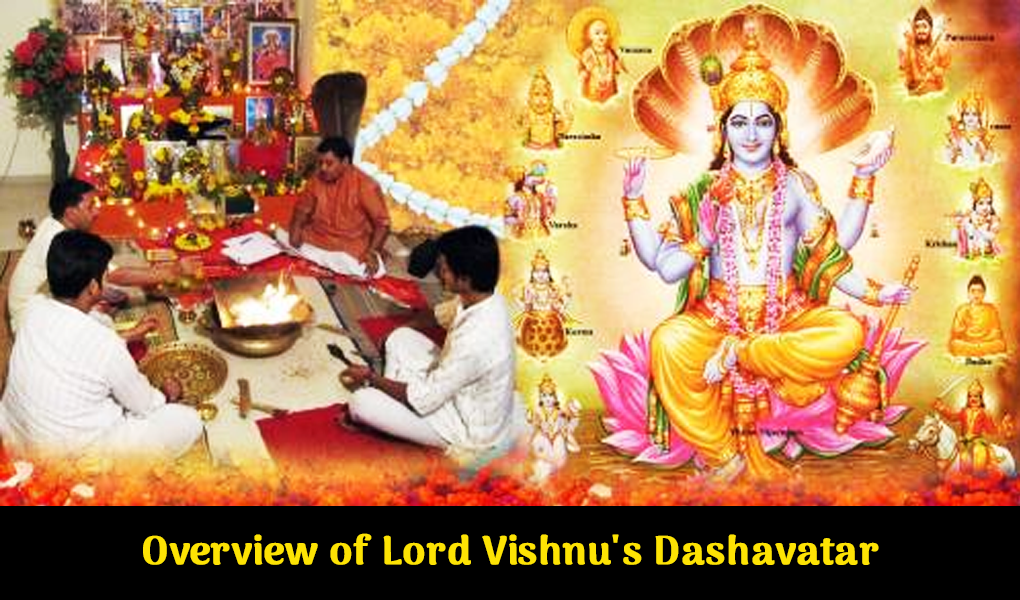Brief Overview of Lord Vishnu’s Dashavatara
Introduction
Lord Vishnu: The Preserver in the Hindu Trinity
In the intricate tapestry of Hinduism, Lord Vishnu stands as one of the principal deities, tasked with the divine responsibility of preserving the balance of the cosmos. Within the Hindu trinity, comprising Brahma the creator, Vishnu the preserver, and Shiva the destroyer, Vishnu’s role is to safeguard dharma (righteousness) and ensure the continuity of the universe.
Lord Vishnu’s Dashavatara: The Ten Incarnations of Vishnu
Central to Lord Vishnu’s cosmic duty are his ten avatars, collectively known as the Dashavatara. These incarnations span various epochs and serve multifaceted purposes, each contributing to the cosmic order and the welfare of all living beings. Let us embark on a journey through the Dashavatara, unravelling the significance and symbolism behind each manifestation.
1. Matsya (The Fish)
Saving the World from the Deluge
Matsya, the first avatar, takes the form of a fish. In this incarnation, Lord Vishnu rescued the Vedas and the saptarishi (seven sages) from a catastrophic deluge. The symbolism lies in salvation, protection, and the preservation of knowledge during times of immense adversity.
Symbolizing Protection and Survival (Lord Vishnu’s Dashavatara)
Matsya signifies the unwavering protection of divine truths and the survival of wisdom through the tempestuous tides of existence.
2. Kurma (The Tortoise)
The Churning of the Ocean of Milk
Kurma, the tortoise, emerged during the churning of the Ocean of Milk, an epic cosmic event. Lord Vishnu’s incarnation as Kurma provided the stable foundation necessary for the divine task of churning the ocean, which yielded the nectar of immortality.
Signifying Balance and Support (Lord Vishnu’s Dashavatara)
Kurma embodies the principles of balance and unwavering support, teaching us the importance of stability in the face of challenges.
3. Varaha (The Boar)
Rescuing the Earth from Demon Hiranyaksha
In the avatar of Varaha, Lord Vishnu manifested as a gigantic boar to rescue the Earth, submerged in the cosmic ocean by the demon Hiranyaksha. This act symbolizes the unwavering determination to protect dharma and restore order.
Representing Strength and Determination (Lord Vishnu’s Dashavatara)
Varaha’s strength and determination inspire us to confront adversity head-on and uphold righteousness.
4. Narasimha (The Man-Lion)
Defeating Demon King Hiranyakashipu
Narasimha, the man-lion, emerged to vanquish the demon king Hiranyakashipu, who could not be killed by man or beast. Lord Vishnu’s unique form, half-man and half-lion, defeated evil while upholding the law of karma.
Symbolizing Courage and Justice (Lord Vishnu’s Dashavatara)
Narasimha exemplifies the courage to confront evil and the unwavering pursuit of justice.
5. Vamana (The Dwarf)
Subduing Demon King Bali
Vamana, the dwarf Brahmin, devised a cunning plan to subdue the benevolent demon king Bali. Through humility and clever strategy, Vamana reclaimed the three worlds for the gods.
Illustrating Humility and Benevolence (Lord Vishnu’s Dashavatara)
Vamana’s incarnation teaches us the power of humility and how intelligence can triumph over brute force.
6. Parashurama (The Warrior with an Axe)
Eradicating Corrupt Kshatriyas
Parashurama, the warrior with an axe, was born to rid the world of corrupt and oppressive Kshatriyas (warrior class). He represents unwavering valor and heroism in the face of injustice.
Embodying Valor and Heroism (Lord Vishnu’s Dashavatara)
Parashurama’s life story inspires us to stand up against tyranny and uphold righteousness.
7. Rama (The Prince of Ayodhya)
The Hero of the Epic Ramayana
Rama, the prince of Ayodhya, is the central figure of the epic Ramayana. His life epitomizes ideal kingship, dharma, and the unwavering devotion to fulfilling one’s duties.
Portraying Ideal Kingship and Dharma
Rama’s journey showcases the importance of adhering to dharma and the sacrifices made in the name of righteousness.
8. Krishna (The Divine Cowherd)
The Central Figure of the Mahabharata
Krishna, the divine cowherd, played a pivotal role in the Mahabharata, offering profound wisdom, guidance, and diplomacy. His life exemplifies love, wisdom, and the art of statesmanship.
Exemplifying Love, Wisdom, and Diplomacy
Krishna’s teachings continue to resonate, emphasizing the path of love, devotion, and righteousness.
9. Buddha (The Enlightened One)
Siddhartha Gautama’s Spiritual Journey
In the avatar of Buddha, Lord Vishnu manifested as Siddhartha Gautama, who embarked on a spiritual quest and ultimately attained enlightenment under the Bodhi tree. This incarnation promotes peace, compassion, and enlightenment.
Promoting Peace, Compassion, and Enlightenment
Buddha’s teachings offer a path to inner peace and universal compassion, transcending the boundaries of faith.
10. Kalki (The Future Warrior)
The Yet-to-Come Avatar
Kalki, the prophesied future avatar, is yet to descend. It is foretold that Kalki will come to end corruption and evil, ushering in a new era of righteousness.
Predicted to End Corruption and Evil
Kalki’s imminent arrival symbolizes hope for a world free from injustice and moral decay.
Conclusion (Lord Vishnu’s Dashavatara)
The Diversity and Significance of Lord Vishnu’s Avatars
In conclusion, the Dashavatara of Lord Vishnu exemplifies the divine diversity and the profound significance of each incarnation. These avatars, spanning across epochs and narratives, serve as timeless guides, imparting invaluable lessons in righteousness, humility, and the unwavering pursuit of dharma. Understanding the symbolism and teachings of these avatars enriches our spiritual journey, offering wisdom that transcends the boundaries of time and space.
Get your Janam Kundali

